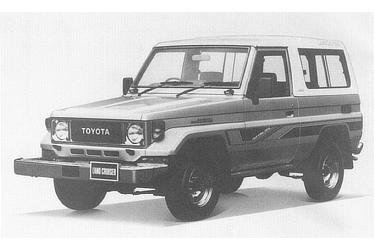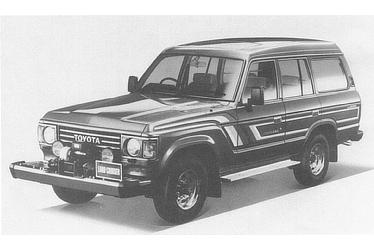Nov. 02, 1984
FULL MODEL CHANGE FOR TOYOTA LAND CRUISER
Responding to Diversified Needs in 4WD Market
TOYOTA MOTOR CORPORATION announced the first full model change of its 4WD Land Cruiser 40 series (short wheelbase model) in 29 years, marketing it as the completely new Land Cruiser 70 series (short and middle wheelbase model). Improvements have also been made to part of the Toyota Land Cruiser 60 series (long wheelbase model), and both series will be marketed simultaneously beginning on November 2.
Since its appearance in 1953, the Land Cruiser has established a reputation for excellent maneuverability and durability owing to its outstanding power performance and solid turning performance, and it enjoys a fine reputation both domestically and abroad as a leader in the 4WD vehicle market.
In recent years, there has been a strong trend toward expansion and diversification in the 4WD market, because leisure-oriented customers who demand more maneuverability and fashionability in their automobiles have been switching to 4WD vehicles.
The Land Cruiser 70 series was developed in the light of this trend, under the basic theme of "Meeting diversifying needs in the 4WD vehicle market." The Land Cruiser series has been transformed so that models in it have a refined style yet preserve the traditional image of being powerful.
In the Land Cruiser 60 series, a 4-speed fully automatic transmission with overdrive and lock-up clutch has been adopted for vehicles with the 2H-type engine (diesel, 6-cylinder, 3980 cc), the first time this transmission has been used in Japan in a 4WD vehicle, and the newly developed 3F-type engine (gasoline, 6-cylinder, 3955 cc) is also available for mounting. These and other refinements have further rounded out the model line, enabling the overall Land Cruiser series to meet the demands of a diversified market.
-
- Exterior and styling
-
The new series carries on the image of the former Land Cruiser 40 series. The use of curved glass for the front windshield ensures a wide field of vision, for example, and innovations such as drawing in the front part have improved its aerodynamic characteristics, reduced fuel consumption during high-speed driving, improved driving stability, and reduced wind noise.Besides the former hood and van types, Toyota has created an FRP top vehicle which uses FRP (fiber-reinforced plastic) in part of the body.The front and back door frames of the hood-type model are removable to open it up fully, leaving only the roll bars.
-
- Interior
-
A roomy interior has been provided by expanding the cabin on the engine room side (150 mm) and lowering the floor (maximum 120 mm). The rear seat collapses forward so that the rear section can be used effectively as luggage space when there are only two passengers.The interior has been made even more comfortable through such measures as the adoption of suspension-type front seats which have a weight-adjustment mechanism (optional in some models) that absorbs vibrations from the road and eases passenger fatigue, and the adoption of seats with changeable shape.
-
- New mechanisms and equipment
-
- One-touch 2-4 selector
- A single touch shifts from H2 to H4 drive.*
- *H2 drive
- "High-range, rear-wheel drive"Used for normal driving.
- *H4 drive
- "High-range, 4-wheel drive"Used on uneven and snowy surfaces.
- Clutch booster
- Reduces the pressure needed to operate the clutch pedal.
- Switches clustered around steering column
- Makes lights and power switches easier to operate.
- Back doors
- Convenient double doors have been adopted in back, and rear visibility has been improved by narrowing the door frames and altering the size of the right and left doors.
Such refinements as enlarging the front and rear door openings and lowering the position of the side steps have also made entering and exiting easier.
-
- Improved durability
- Besides welding the chassis frame section closed, the sectional form has also been enlarged and its strength and rigidity improved. Durability has been improved through the use of thick outside plating (1.0 mm) on the body, and special attention was given in design to corrosion prevention.
- Land Cruiser 60 Series
-
A newly developed automatic transmission and engine have made this series even more attractive.
-
- Use of 4-speed, fully automatic transmission with overdrive and lock-up clutch
- Ease of handling in both on-road and off-road driving has been improved through the optimum compatibility of the newly developed 4-speed, fully automatic transmission with overdrive and lock-up clutch (used for the first time in a 4WD vehicle in Japan) and the improved 2H engine (diesel, 6-cylinder, 3980 cc).
-
- Newly developed 3F-type engine
-
The former 2F-type engine (gasoline, 6-cylinder, 4230 cc) has been replaced by a new 3F-type engine (gasoline, 6-cylinder, 3955 cc). The new engine has improved on the former one by making the engine body smaller and lighter and altering its stroke. Total displacement has been reduced, but maximum output is 15 ps greater than that of the 2F-type engine. Fuel consumption has also improved (from the former 9.5 km/L to 10.5 km/L―in the 60 km/h constant-speed test over a course). The 3F-type is a high-performance engine with low fuel consumption.
- Engine
- 3F-type
- Total displacement (cc)
- 3955
- Maximum output (ps/rpm)
- 155/4,200
- Maximum torque (kg-m/rpm)
- 30.0/2,200
-


LAND CRUISER 70 SERIES FRP TOP MODEL







